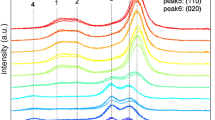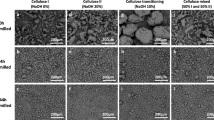Abstract
Given that terahertz (THz) radiation responds to intermolecular forces such as hydrogen bonds, THz time-domain spectroscopy (THz-TDS) has expanded possibilities in cellulose research. In this study, THz-TDS was used to investigate the crystallinity of three types of cellulose-based materials. Microcrystalline cellulose (MCC) and wood were ball milled at different times, and pseudo-wood was a mixture of MCC and lignin of different mass fractions. All the samples showed peaks at 3.04 THz in the THz mass absorption coefficient spectra. Further, the spectra from 2.79 THz to 3.32 THz were cut out and detrended by subtraction from a baseline. The integrated intensity of the detrended spectra showed a correlation with the mass fraction of lignin of the pseudo-wood samples, and ball milling time of the MCC and wood samples. The correlation was similar with the crystallinity index calculated from X-ray powder diffraction. Moreover, the original wood sample without ball milling had an integrated intensity that was about 30% that of the original MCC sample, matching with the cellulose concentration of the wood (about 30% to 40%). We normalized the integrated intensity of 2.79 THz to 3.32 THz into 1 to 0 by a min–max algorithm and proposed a new “index” for evaluating crystallinity.





Similar content being viewed by others
Availability of data and materials
None.
References
Braly LB, Liu K, Brown MG et al (2000) Terahertz laser spectroscopy of the water dimer intermolecular vibrations. II. (H2O)2. J Chem Phys 112:10314–10326
de Keijser T, Mittemeijer EJ, Rozendaal HCF (1983) The determination of crystallite-size and lattice-strain parameters in conjunction with the profile-refinement method for the determination of crystal structures. J Appl Crystallogr 16:309–316
del Cerro DR, Koso TV, Kakko T et al (2020) Crystallinity reduction and enhancement in the chemical reactivity of cellulose by non-dissolving pre-treatment with tetrabutylphosphonium acetate. Cellulose 27:5545–5562
Density ANDC, Kellogg RM, Sastr CBR, Ivellwood RW (1975) Relationships between Cell-Wall Composition 7:170–177
Duvillaret L, Garet F, Coutaz JL (1996) A reliable method for extraction of material parameters in terahertz time-domain spectroscopy. IEEE J Sel Top Quantum Electron 2:739–745
French AD (2014) Idealized powder diffraction patterns for cellulose polymorphs. Cellulose 21:885–896
French AD, Santiago Cintrón M (2013) Cellulose polymorphy, crystallite size, and the Segal Crystallinity Index. Cellulose 20:583–588
Hall M, Bansal P, Lee JH et al (2010) Cellulose crystallinity - A key predictor of the enzymatic hydrolysis rate. FEBS J 277:1571–1582
Hermans PH, Weidinger A (1948) Quantitative x-ray investigations on the crystallinity of cellulose fibers. A Background Analysis J Appl Phys 19:491–506
Himmel ME, Ding S, Johnson DK, et al. (2007) Biomass recalcitrance: engineering plants and enzymes for biofuels production. Science 315(5813):804–807.
Hindeleh AM, Johnson DJ (1972) Crystallinity and crystallite size measurement in cellulose fibres: 1. Ramie and Fortisan Polymer (guildf) 13:423–430
Inagaki T, Ahmed B, Hartley ID et al (2014a) Simultaneous prediction of density and moisture content of wood by terahertz time domain spectroscopy. J Infrared, Millimeter, Terahertz Waves 35:949–961
Inagaki T, Hartley ID, Tsuchikawa S, Reid M (2014b) Prediction of oven-dry density of wood by time-domain terahertz spectroscopy. Holzforschung 68:61–68
Inagaki T, Siesler HW, Mitsui K, Tsuchikawa S (2010) Difference of the crystal structure of cellulose in wood after hydrothermal and aging degradation: a NIR spectroscopy and XRD study. Biomacromol 11:2300–2305
Jörgensen L, Kiessling R, Lindstedt G, Kinell P-O (1950) Swelling and heterogeneous hydrolysis of cotton linters and wood pulp fibers related to their fine structure. Acta Chem Scand 4:185–199
Kataoka Y, Kondo T (1998) FT-IR microscopic analysis of changing cellulose crystalline structure during wood cell wall formation. Macromolecules 31:760–764
Kim SH, Lee CM, Kafle K (2013) Characterization of crystalline cellulose in biomass: Basic principles, applications, and limitations of XRD, NMR, IR, Raman, and SFG. Korean J Chem Eng 30:2127–2141
Kore PS, Pawar PP (2014) Measurements of mass attenuation coefficient, effective atomic number and electron density of some amino acids. Radiat Phys Chem 98:86–91
Langan P, Sukumar N, Nishiyama Y, Chanzy H (2005) Synchrotron X-ray structures of cellulose Iβ and regenerated cellulose II at ambient temperature and 100 K. Cellulose 12:551–562
Ling Z, Wang T, Makarem M et al (2019) Effects of ball milling on the structure of cotton cellulose. Cellulose 26:305–328
Markelz AG (2008) Terahertz dielectric sensitivity to biomolecular structure and function. IEEE J Sel Top Quantum Electron 14:180–190
Nishiyama Y (2009) Structure and properties of the cellulose microfibril. J Wood Sci 55:241–249
Nishiyama Y, Langan P, Chanzy H (2002) Crystal structure and hydrogen-bonding system in cellulose Iβ from synchrotron X-ray and neutron fiber diffraction. J Am Chem Soc 124:9074–9082
Parthasarathi R, Bellesia G, Chundawat SPS et al (2011) Insights into hydrogen bonding and stacking interactions in cellulose. J Phys Chem A 115:14191–14202
Peccianti M, Fastampa R, Mosca Conte A et al (2017) Terahertz absorption by cellulose: applicationto ancient paper artifacts. Phys Rev Appl 7:1–7
PETTERSEN RC (1984) The chemical composition of wood. The chemistry of solid wood, 57–126.
Plusquellic DF, Siegrist K, Heilweil EJ, Esenturk O (2007) Applications of terahertz spectroscopy in biosystems. ChemPhysChem 8:2412–2431
Poletto M, Zattera AJ, Forte MMC, Santana RMC (2012) Thermal decomposition of wood: Influence of wood components and cellulose crystallite size. Bioresour Technol 109:148–153
Segal L, Creely JJ, Martin AE, Conrad CM (1959) An Empirical Method for Estimating the Degree of Crystallinity of Native Cellulose Using the X-Ray Diffractometer. Text Res J 29(10): 786–794
Teeäär R, Serimaa R, Paakkarl T (1987) Crystallinity of cellulose, as determined by CP/MAS NMR and XRD methods. Polym Bull 17:231–237
Thygesen A, Oddershede J, Lilholt H et al (2005) On the determination of crystallinity and cellulose content in plant fibres. Cellulose 12:563–576
Updegraff DM (1969) Semimicro determination of cellulose inbiological materials. Anal Biochem 32:420–424
Vieira FS, Pasquini C (2014) Determination of cellulose crystallinity by terahertz-time domain spectroscopy. Anal Chem 86:3780–3786
Wada M, Okano T, Sugiyama J (1997) Synchrotron-radiated X-ray and neutron diffraction study of native cellulose. Cellulose 4:221–232
Wang H, Horikawa Y, Tsuchikawa S, Inagaki T (2020) Terahertz time-domain spectroscopy as a novel tool for crystallographic analysis in cellulose. Cellulose 27:9767–9777
Wang H, Inagaki T, Hartley ID et al (2019) Determination of dielectric function of water in THz region in wood cell wall result in an accurate prediction of moisture content. J Infrared, Millimeter, Terahertz Waves 40:673–687
Xie L, Yao Y, Ying Y (2014) The application of terahertz spectroscopy to protein detection: a review. Appl Spectrosc Rev 49:448–461
Yao W, Weng Y, Catchmark JM (2020) Improved cellulose X-ray diffraction analysis using Fourier series modeling. Cellulose 27:5563–5579
Acknowledgments
The authors would like to express our grateful appreciation to Dr. Liu and Dr. Wang for the supplement of the organic-solvent lignin samples. This work was supported by JSPS KAKENHI Grant Number 16H02559. The XRD measurement was supported by Radioisotope Research Center, Nagoya University. And the first author also thanks for the Mitsutani scholarship for living support.
Funding
JSPS KAKENHI Grant Number 16H02559.
Author information
Authors and Affiliations
Contributions
Han Wang and Tetsuya Inagaki conceived and designed the experiments. Han Wang performed the experiments, analyzed the data and wrote the paper, Tetsuya Inagaki and Satoru Tsuchikawa gave final approval of the manuscript.
Corresponding author
Ethics declarations
Conflict of interest
None.
Ethical standards
This study following Compliance with Ethical Standards; this study does not involve human participants, animals, and potential conflicts of interest.
Additional information
Publisher's Note
Springer Nature remains neutral with regard to jurisdictional claims in published maps and institutional affiliations.
Supplementary Information
Below is the link to the electronic supplementary material.
Rights and permissions
About this article
Cite this article
Wang, H., Tsuchikawa, S. & Inagaki, T. Terahertz time-domain spectroscopy as a novel tool for crystallographic analysis in cellulose: the potentiality of being a new standard for evaluating crystallinity. Cellulose 28, 5293–5304 (2021). https://doi.org/10.1007/s10570-021-03902-x
Received:
Accepted:
Published:
Issue Date:
DOI: https://doi.org/10.1007/s10570-021-03902-x




